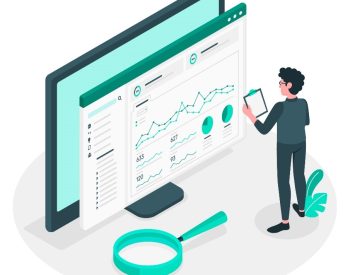Top 5 Ways Real-time ERP Data Analytics Helps in Textile Manufacturing
Keeping track of inventory levels, order status and specifications, daily work output, resource allocations, machine breakdowns, and other critical elements in a textile manufacturing business can seem impossible when done manually.
The textile manufacturing process involves numerous moving parts, making it challenging to monitor everything effectively. This is precisely why ERP software is essential. This blog will help you understand the role of real-time ERP data analytics in the textile industry and why implementing it will be the best decision you can make. Let’s get started.
5 Ways Real-time ERP Data Analytics Helps the Textile Industry
Performing real-time data analytics in the textile business via ERP software increases efficiency by giving real-time visibility into inventory levels, supply chain dynamics, and production processes. Let us discuss the role of real-time ERP tracking and monitoring:
1) Improved Production Efficiency
Real-time ERP monitoring enhances production efficiency in the textile industry. The ERP software gives immediate details of performance by continuously monitoring production processes. For instance, they can detect bottlenecks in the production line, machine malfunctions, or delays in material supply.

Key Benefits:
- Predictive Maintenance Alerts help prevent machine breakdowns, reducing downtime and increasing productivity.
- Resource Optimization through real-time data allows for optimal allocation of resources, ensuring that machinery and labor are utilized effectively.
- Automates Routine Tasks based on analyzed data in turn streamlining operations and reduce manual intervention.
2) Improved Quality Control
Real-time data analytics plays a pivotal role in maintaining high quality in textile production. ERP software is equipped with real-time ERP tracking of quality metrics throughout the production process, from raw material inspection to finished goods.
Key Benefits:
- Immediate Error Detection helps in taking corrective actions swiftly, minimizing waste and rework.
- Standard Compliance ensures that products meet industry standards and customer specifications consistently.
- High-Quality Products lead to increased customer satisfaction and loyalty, enhancing the company’s reputation.
3) Optimized Supply Chain Management
Navigating the supply chain of the textile industry is a complex process as it involves various suppliers, manufacturers, and distributors. Real-time ERP tracking optimizes supply chain management by providing real-time visibility of production planning, warehousing, packaging, status of orders, failed deliveries, etc.
Key Benefits:
- Real-Time Tracking of Inventory Levels helps in maintaining optimal stock, reducing the risks of overstocking or stockouts.
- Supplier Collaboration enhances communication and collaboration with suppliers based on real-time data improving supply chain reliability and efficiency.
- Real-Time Insights into Logistics Operations enable better planning and coordination, reducing lead times and transportation costs.
4) Effective Decision Making
In the textile industry, making data-driven decisions help manufacturers make the right choices when it comes to making textile supply chain processes efficient. Real-time ERP monitoring assists manufacturers with ERP business insights, which in turn help them make strategic and operational decisions.
Key Benefits:
- Analyzing Current Market Trends and consumer preferences allows businesses to adapt quickly to changing consumer demands.
- Monitoring of Key Performance Indicators (KPIs) helps in evaluating operational performance and identifying areas for improvement.
- Scenario Planning and Risk Management enables businesses to prepare contingency plans for potential breakdown of processes effectively.
5) Improving Customer Service
In the textile industry providing quality customer service is essential. Real-time data analytics integrated with ERP systems plays an important role in enhancing customer service by improving order tracking, enabling personalized solutions, and facilitating quick complaint resolution.
Key Benefits:
- Real-time ERP Tracking provides accurate order status updates to customers, improving transparency and trust.
- Insights Of Customer Behavior and Preferences enable personalized offerings and improved customer experiences.
- Quick Identification and Resolution of Issues like failed deliveries and order misplacements based on real-time data improves customer satisfaction and loyalty.
Future Trends of Real-time ERP Data Analytics in Textile Industry
As technology continues to advance, the integration of real-time data analytics and ERP systems in the textile industry is set to evolve further. The shift to cloud-based ERP solutions is already offering better scalability, flexibility, and accessibility, allowing businesses to leverage real-time data analytics from anywhere, anytime.
Some of the expected future trends in the textile industry are:
- AI and Machine Learning: Integration of advanced AI and machine learning algorithms will enhance predictive analytics, providing even deeper insights into production optimization and demand forecasting.
- IoT Integration: Integration of the Internet of Things (IoT) will enable more comprehensive real-time data collection from connected devices and machinery, leading to smarter and more responsive production environments.
- Blockchain Technology: Integration of Blockchain will enhance transparency and traceability in the supply chain, ensuring the authenticity of raw materials and finished products.
- Sustainability Analytics: Integration of ESG principles in real-time data analytics will increasingly focus on sustainability metrics, helping textile companies reduce their environmental impact and comply with regulatory standards.
ERP software, through real-time data analytics, is transforming the textile industry by enhancing production efficiency, quality control, supply chain management, decision-making, and customer service. This integration provides real-time visibility into operations, optimizing resource allocation, and ensuring compliance with industry standards. As technology advances, future trends such as AI, IoT and blockchain technology will further revolutionize the industry. Ultimately, adopting real-time ERP data analytics positions textile businesses to thrive in a dynamic market, ensuring long-term success and innovation.

